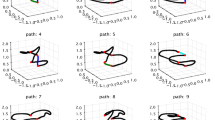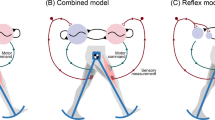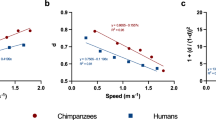Abstract
Although people's legs are capable of a broad range of muscle-use and gait patterns, they generally prefer just two. They walk, swinging their body over a relatively straight leg with each step, or run, bouncing up off a bent leg between aerial phases. Walking feels easiest when going slowly, and running feels easiest when going faster. More unusual gaits seem more tiring. Perhaps this is because walking and running use the least energy1,2,3,4,5,6,7. Addressing this classic1 conjecture with experiments2,3 requires comparing walking and running with many other strange and unpractised gaits. As an alternative, a basic understanding of gait choice might be obtained by calculating energy cost by using mechanics-based models. Here we use a minimal model that can describe walking and running as well as an infinite variety of other gaits. We use computer optimization to find which gaits are indeed energetically optimal for this model. At low speeds the optimization discovers the classic inverted-pendulum walk8,9,10,11,12,13, at high speeds it discovers a bouncing run12,13, even without springs, and at intermediate speeds it finds a new pendular-running gait that includes walking and running as extreme cases.
This is a preview of subscription content, access via your institution
Access options
Subscribe to this journal
Receive 51 print issues and online access
$199.00 per year
only $3.90 per issue
Buy this article
- Purchase on Springer Link
- Instant access to full article PDF
Prices may be subject to local taxes which are calculated during checkout




Similar content being viewed by others
References
Borelli, G. A. De Motu Animalium, Pars Prima (On the Movement of Animals) (Angeli Bernabo, Rome, 1680)
Margaria, R. Biomechanics and Energetics of Muscular Exercise (Clarendon, Oxford, 1977)
Hoyt, D. F. & Taylor, C. R. Gait and the energetics of locomotion in horses. Nature 292, 239–240 (1981)
Alexander, R. McN. Optimum walking techniques for quadrupeds and bipeds. J. Zool. Lond. 192, 97–117 (1980)
Alexander, R. McN. Optimization and gaits in the locomotion of vertebrates. Physiol. Rev. 69, 1199–1227 (1989)
Alexander, R. McN. A model of bipedal locomotion on compliant legs. Phil. Trans. R. Soc. Lond. B 338, 189–198 (1992)
Minetti, A. E. & Alexander, R. McN. A theory of metabolic costs for bipedal gaits. J. Theor. Biol. 186, 467–476 (1997)
Alexander, R. McN. in Perspectives in Experimental Biology Vol. 1 (ed. Davies, P. S.) 493–504 (Pergamon, New York, 1976)
Cavagna, G. A., Heglund, N. C. & Taylor, C. R. Mechanical work in terrestrial locomotion: two basic mechanisms for minimizing energy expenditure. Am. J. Physiol. 233, R243–R261 (1977)
Alexander, R. McN. Simple models of human motion. Appl. Mech. Rev. 48, 461–469 (2003)
Kuo, A. D. Energetics of actively powered locomotion using the simplest walking model. J. Biomech. Eng. 124, 113–120 (2002)
Ruina, A., Bertram, J. E. A. & Srinivasan, M. A collisional model of the energetic cost of support work qualitatively explains leg sequencing in walking and galloping, pseudo-elastic leg behavior in running and the walk-to-run transition. J. Theor. Biol. [online], 14 June 2005 (doi:10.1016/j.jtbi.2005.04.004)
Kuo, D. A., Donelan, J. M. & Ruina, A. Energetic consequences of walking like an inverted pendulum: step-to-step transitions. Exercise Sport Sci. Rev. 3, 88–97 (2005)
Rashevsky, N. Studies in the physico-mathematical theory of organic form. Bull. Math. Biophys. 6, 1–59 (1944)
Alexander, R. McN. Elastic Mechanisms in Animal Movement (Cambridge Univ. Press, Cambridge, 1988)
McMahon, T. A. & Cheng, G. C. The mechanics of running: how does stiffness couple with speed? J. Biomech. 23 (Suppl. 1), 65–78 (1990)
Blickhan, R. & Full, R. J. Similarity in multilegged locomotion: bouncing like a monopode. J. Comp. Physiol. A 173, 509–517 (1993)
Kuo, A. D. A simple model predicts the step length-speed relationship in human walking. J. Biomech. Eng. 123, 264–269 (2001)
Thorstensson, A. & Robertson, H. Adaptations to changing speed in human locomotion: speed of transition between walking and running. Acta Physiol. Scand. 131, 211–214 (1987)
Minetti, A. E., Ardigo, L. P. & Saibene, F. The transition between walking and running in humans: metabolic and mechanical aspects at different gradients. Acta Physiol. Scand. 150, 315–323 (1994)
Farley, C. T. & Ortega, J. D. Minimizing center of mass vertical movement increases metabolic cost in walking. J. Appl. Physiol. [online], 28 July 2005 (doi:10.1152/japplphysiol.00103.2005)
Gordon, K., Ferris, D. & Kuo, A. Proc. 27th Annual Meeting, American Society of Biomechanics Abstr. 113 (American Society of Biomechanics, Toledo, Ohio, 2003)
Bramble, D. M. & Lieberman, D. E. Endurance running and the evolution of Homo. Nature 432, 345–352 (2004)
Marsh, R. L. et al. Partitioning the energetics of walking and running: swinging the legs is expensive. Science 303, 80–83 (2004)
Kram, R. & Taylor, C. R. Energetics of running: a new perspective. Nature 346, 265–267 (1990)
Minetti, A. E. The biomechanics of skipping gaits: a third locomotor paradigm? Proc. R. Soc. Lond. B 265, 1227–1235 (1998)
Anderson, F. C. & Pandy, M. G. Dynamic optimization of human walking. J. Biomech. Engng 123, 381–390 (2001)
Gill, P. E., Murray, W. & Saunders, M. A. SNOPT: An SQP algorithm for large-scale constrained optimization. SIAM J. Optim. 12, 979–1006 (2002)
Bryson, A. E. & Ho, Y. C. Applied Optimal Control (John Wiley, New York, 1975)
Bertram, J. E. A., D'Antonio, P., Pardo, J. & Lee, D. V. Pace-length effects in human walking: ‘Groucho gaits’ revisited. J. Mot. Behav. 34, 309–318 (2002)
Acknowledgements
We thank J. Bertram for extensive discussions on related topics; J. Burns, A. Chatterjee, P. Holmes, A. Schwab, S. Strogatz, S. van Nouhuys and S. Walcott for editorial and technical comments. Author Contributions M.S. formulated the mechanical model and performed the numerical optimizations. This was partly informed by extensive discussions with A.R. during the writing of ref. 12, and from a course taught by A.R. The authors contributed equally to the analytic calculations, the interpretation of the results and to the writing of the paper.
Author information
Authors and Affiliations
Corresponding author
Ethics declarations
Competing interests
Reprints and permissions information is available at npg.nature.com/reprintsandpermissions. The authors declare no competing financial interests.
Rights and permissions
About this article
Cite this article
Srinivasan, M., Ruina, A. Computer optimization of a minimal biped model discovers walking and running. Nature 439, 72–75 (2006). https://doi.org/10.1038/nature04113
Received:
Accepted:
Published:
Issue Date:
DOI: https://doi.org/10.1038/nature04113
This article is cited by
-
Quantifying changes in individual-specific template-based representations of center-of-mass dynamics during walking with ankle exoskeletons using Hybrid-SINDy
Scientific Reports (2024)
-
Learning Multiple-Gait Quadrupedal Locomotion via Hierarchical Reinforcement Learning
International Journal of Precision Engineering and Manufacturing (2023)
-
Energy Expenditure of Adolescents During Overground Walking and Running
Journal of Science in Sport and Exercise (2023)
-
Bipedal walking control by using acceleration factor
Nonlinear Dynamics (2023)
-
Mechanical intelligence for learning embodied sensor-object relationships
Nature Communications (2022)
Comments
By submitting a comment you agree to abide by our Terms and Community Guidelines. If you find something abusive or that does not comply with our terms or guidelines please flag it as inappropriate.



